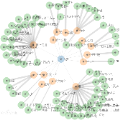Knowledge graph completion (a.k.a.~link prediction), i.e.,~the task of inferring missing information from knowledge graphs, is a widely used task in many applications, such as product recommendation and question answering. The state-of-the-art approaches of knowledge graph embeddings and/or rule mining and reasoning are data-driven and, thus, solely based on the information the input knowledge graph contains. This leads to unsatisfactory prediction results which make such solutions inapplicable to crucial domains such as healthcare. To further enhance the accuracy of knowledge graph completion we propose to loosely-couple the data-driven power of knowledge graph embeddings with domain-specific reasoning stemming from experts or entailment regimes (e.g., OWL2). In this way, we not only enhance the prediction accuracy with domain knowledge that may not be included in the input knowledge graph but also allow users to plugin their own knowledge graph embedding and reasoning method. Our initial results show that we enhance the MRR accuracy of vanilla knowledge graph embeddings by up to 3x and outperform hybrid solutions that combine knowledge graph embeddings with rule mining and reasoning up to 3.5x MRR.
翻译:知识图的完成(a.k.a. ~link预测) 知识图的完成(a.k.a. ~link 预测), 也就是说, 将知识图的缺失信息从知识图中推断出来的任务, 是许多应用中广泛使用的一项任务, 例如产品建议和问题回答。 知识图嵌入和(或)规则的开采和推理的最先进的知识图方法, 是数据驱动的, 因此, 仅以输入知识图所包含的信息为基础。 这导致不令人满意的预测结果, 使这些解决方案无法适用于卫生保健等关键领域。 为了进一步提高知识图的准确性, 我们提议将知识图中的数据驱动力与来自专家或必然制度( 如OWL.2) 的域性推理嵌入( 如OWL2)。 这样, 我们不仅能用可能不包含在输入知识图中的域知识来提高预测准确性, 而且还能让用户插插插插出他们自己的知识图嵌入和推理方法。 我们的初步结果显示, 我们用3x和外形混合解决方案, 将知识图嵌入与规则的嵌入和推理与3.5 MRRRx 。




